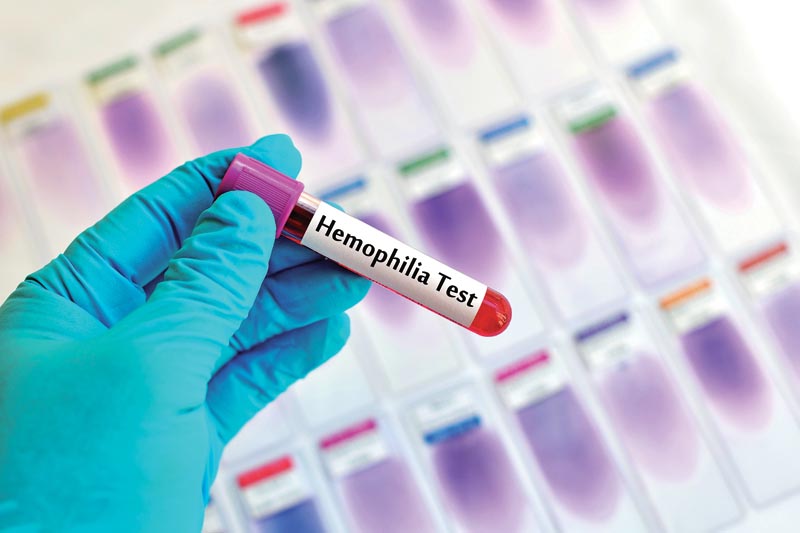Haemophilia: Disorder of blood coagulation
Blood is in the liquid state when inside the blood vessels — arteries and veins — while carrying oxygen, nutrients and carbon dioxide to and from the heart. But whenever it bleeds outside the blood vessels, blood thickens and forms a gel. This process of forming a gel is called blood clotting or blood coagulation — a process in which the liquid blood is transformed into a solid state. The plasma proteins in the platelets help blood to change its state to solid. When there is deficiency in coagulation factors, one’s blood may not clot resulting in loss of blood.
“Thirteen coagulation factors combine to form a clot, and when there is deficiency in one of these factors, then there is disorder in the blood clot. Haemophilia is one such blood clot disorder,” Dr Ajay Kumar Jha, Haematologist at Bhaktapur Cancer Hospital, Bhaktapur informed of the disorder. Raising awareness and understanding of haemophilia, April 17 is celebrated around the globe as World Haemophilia Day.
From among the XIII coagulation factors, whenever there is a deficiency of factor VIII and factor IX in blood, then there is bleeding disorder. “If there is a deficiency of factor VIII, then it is Haemophilia A — this is the common type. When there is deficiency of factor IX, then it is termed as Haemophilia B. In both cases, the needed factors could be missing, or are very low,” he pointed out.
Haemophilia is divided into three levels — mild, moderate and severe.
Dr Jha explained, “When these coagulation factors are less than one per cent, then it is known as severe haemophilia. When it is within the ranges of one to five per cent, it is moderate haemophilia; when it is within the ranges of five to 40 per cent, it is mild haemophilia. If it is above 40 per cent, then it is normal range.”
In severe haemophilia, as per the doctor, spontaneous bleeding is likely to occur in joints, muscles, head and stomach whereas bleeding occurs only after serious injuries in mild and moderate haemophilia. “Bleeding could be both internal and external,” he added.
The symptoms include “swelling, pain and stiffness in knees and ankles, aches and problems while moving muscles, blue patches on the body, bleeding for a long time, prolonged bleeding after tooth/teeth extraction and from cuts”. Continuous bleeding from a small would, vomiting blood and blood in stool are some other symptoms.
The doctor further mentioned, “The joints of patients get damaged and it becomes difficult to carry on normal daily life activities,” suggesting, “If patients are experiencing acute pain, then they should elevate their limbs so as to reduce swelling, apply ice or any cold items to reduce pain, give rest to joints and should opt for hospital-based treatment.”
But the best treatment for haemophilia is “replacement therapy”. According to the doctor, clotting factors VIII and IX can be injected in this therapy for which “we need fresh frozen plasma and cryoprecipitate — frozen blood product prepared from plasma for haemophilia”. So, he emphasised, “This is why a team of experts along with blood banks are necessary.”
Genetic disorder
Haemophilia is a genetic disorder which is seen only in males.
“Sex chromosomes X and Y are inherited from parents. A female inherits one X chromosome from mother and one X chromosome from father (XX), while a male inherits one X chromosome from mother and one Y chromosome from father (XY). The gene that causes haemophilia is located in the X chromosome. Females have double X chromosomes and the disease isn’t manifested in them. They become the carriers of the disease. But as males have single X chromosome in them, the disease is manifested in them,” he explained of the genetic relation.
Haemophilia can be easily diagnosed and at a young age.
“If a child falls down or bumps his joints while playing, parents should check if there are blue patches, is bleeding for a long time, and has swollen joints. If these are seen, then it is haemophilia. Children of ages five to seven with haemophilia disorder experience bleeding while extracting their tooth/teeth,” Dr Jha said adding, “When the same child reaches adulthood, there is prolonged bleeding even from cuts while shaving and from dental extraction.”
Haemophilia is diagnosed by “taking a blood sample and testing the levels of clotting factors VIII and IX”. As per the doctor, family history of patients on the mother’s side is also looked into to “trace and to find the roots”. He advised, “Consanguineous marriage should be avoided.”






